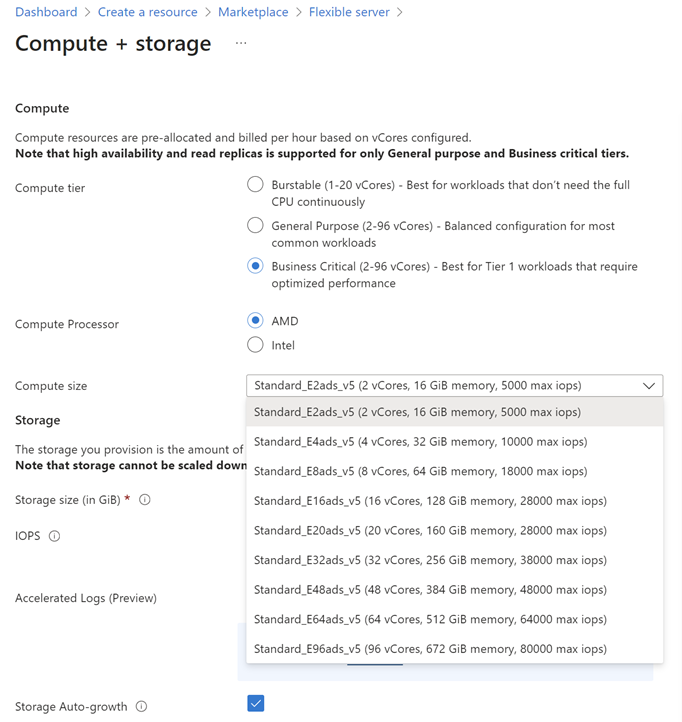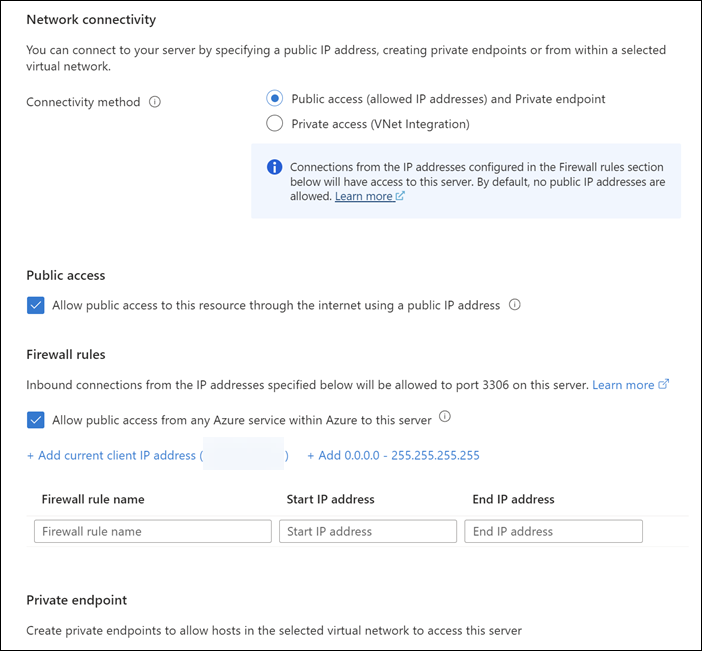Azure Database for MySQL
In this unit, you examine how Azure Database for MySQL can help build a resilient, performant, and easy-to-maintain data store for your web-based app. Considering the expected business criticality and high demand, you're interested in its ability to scale compute and storage resources. You also want to ensure that Azure Database for MySQL minimizes management and maintenance overhead as a managed service, allowing you to focus on software development instead.
What are the core characteristics of Azure Database for MySQL?
Azure Database for MySQL - Flexible Server is designed to deliver complete compatibility with your existing MySQL applications, supporting the widely used MySQL Community Server versions 5.7 and 8.0. This hosting option is particularly effective for scenarios that require:
- Detailed control over compute and storage configurations.
- Consistently high performance.
- Reliable, high availability, and business continuity.
- Efficient cost management strategies.
In addition, Flexible Server enhances security with its built-in firewall for public endpoints and supports private connectivity via Azure Virtual Network (virtual network) integration and Azure Private Link, which safeguards your data from unauthorized access.
Compute
Azure Database for MySQL - Flexible Server is available in three compute tiers, with each tier geared toward a specific use case:
- Burstable: Ideal for development or temporary projects with intermittent performance demands.
- General Purpose: Suitable for a broad range of production workloads requiring balanced compute and memory.
- Business Critical: Best for applications needing high compute performance and resilience.
The specific tier name is derived from the Azure VM Stock Keeping Unit (SKU) series name hosting the managed MySQL Server deployment. Within each tier, you can choose from several different VM sizes, each offering a different number of vCores (ranging from 1 to 96) and amount of memory (ranging from 4 gigabytes (GB) to about 700 GB).
The Burstable compute tier uses B-series VMs, General Purpose relies on Dadsv5-series (AMD) and Ddsv4-series (Intel) VMs, and Business Critical runs on Standard Eadsv5-series (AMD) and Edsv5-series (Intel) VMs.
In the Azure portal, during the server creation process, you can select the tier option on the Basics page, under Server details, or on the Flexible server Compute + storage page, under Compute.

Storage
While provisioning a server or at any point after that, you can increase the amount of storage allocated up to the limit of 16,384 gibibytes (GiB), or 16 tebibytes (TiB) for the Burstable and General Purpose tiers, and 32 TiB for the Business Critical tier. The lower limit (20 GiB) is the same regardless of the selected compute tier and size. In addition, storage sizing is independent of the compute tier and size you choose, and you can also enable storage autogrowth.
Note
After increasing the amount of storage, you cannot decrease it.
Regardless of the storage size, you can also scale up and down the desired limit of Input/Output operations per second (IOPS). The upper limit of available IOPS depends on the compute tier and size, reaching 80,000 IOPS for the largest available size of the Business Critical SKU. You can use this scalable IOPS functionality to accommodate dynamically changing resource requirements at any time and also enable autoscale IOPS to automatically adjust based on workload demands.
Network connectivity
Azure Database for MySQL - Flexible Server supports the three connectivity methods, public access, private access and a private link.

Public access
With public access, which is provided via an external endpoint, you must explicitly allow access using firewall rules:
- For external traffic, you must specify an individual IP address or an IP address range from which the traffic is allowed.
- For traffic originating from Azure, you need to allow public access from any Azure service.
Important
Because public access allows connections from IP addresses allocated to any Azure resource, including connections from other customers' subscriptions, it is only recommended for use in development and testing scenarios.
Private access
Use virtual network integration support for private access via designated Azure virtual networks. You can use private access to securely connect to a MySQL flexible server from within the same VNet, from a different VNet using peering, or even from on-premises using an ExpressRoute or VPN connection. If you enable this option, the server automatically blocks connections that originate from the Internet.
Note
Before enabling private access, custom Domain Name Service (DNS) name resolution must be implemented. For more information, see Private Network Access using virtual network integration for Azure Database for MySQL - Flexible Server.
Private link
Private link provides a private IP address endpoint within a VNet subnet to connect to the MySQL flexible server directly. Azure Private Link essentially brings Azure services inside your private VNet via an IP address like any other VNet resource. You can create several private endpoints, for example one per connecting application or Azure PaaS resource. Combined with NSG firewall rules, private links provide fine-grained control over which services can access the database.
By default, the server enforces Transport Layer Security (TLS 1.2) to help protect incoming network communication.
Important
While you can allow unencrypted connections after server provisioning, it is not recommended.
High availability
Azure Database for MySQL - Flexible Server supports high availability with automatic failover to help ensure that committed data is never lost due to localized failures. When you enable this functionality, the platform automatically provisions and manages a standby replica.
There are two high-availability architectural models, depending on the replica's placement.
Zone-Redundant High Availability
For enhanced resiliency, the zone-redundant high availability model positions the primary database in one availability zone and its standby replica in a separate zone. This configuration is designed to safeguard against data center-level failures, offering a higher level of data protection by ensuring that the primary and backup databases aren't subject to the same localized risks. This model is recommended for critical applications that have continuity and data integrity as paramount goals, as it allows the service to remain available even if an entire data center goes offline.
Same-Zone High Availability
The same-zone high availability model situates the primary database and its standby replica within the same availability zone. Opting for a same-zone deployment is beneficial for scenarios in which minimal latency is crucial for application performance. Maintaining both the primary instance and its replica in close physical proximity ensures that the failover process doesn't significantly impact response times. This setup is ideal for applications impacted even by minimal latency differences, which can affect functionality or user experience.
Business continuity
Azure Database for MySQL - Flexible Server automatically creates point-in-time backups of its databases. It retains them in locally redundant storage for up to 35 days or 10 years when using long-term retention. When configuring backup, you can choose locally redundant, zone-redundant, or geo-redundant backups, allowing you to recover from an outage affecting an entire Azure region. Additionally, you can perform on-demand backups anytime to create a backup snapshot outside the regular backup schedule.
Azure Database for MySQL also supports managed maintenance windows intended for automated server patching, facilitating business continuity. By specifying a custom patching schedule, you can minimize the effect of a temporary downtime resulting from the server restart.
Cost optimization
Azure Database for MySQL - Flexible Server offers numerous options for optimizing costs.
Granular control over compute and storage configuration. You can adjust most server configuration options independently, allowing you to optimize your deployment costs based on your objectives and its intended use case. For example, you can separately adjust options for:
- Compute SKU
- The amount of storage
- IOPS
- The backup retention period
Additionally, you can also enable autoscale IOPS functionality to automatically adjust IOPS based on workload demands. Unlike the Pre-provisioned IOPS, which specifies a fixed IOPS limit and is paid for regardless of usage, Autoscale IOPS lets you pay only for the number of I/O operations that you consume.
The ability to stop and start the server on-demand. The compute tier billing stops as soon as you stop the server. This ability can help you minimize costs during development, testing, and production workloads with a reliably predictable schedule.
The Burstable compute tier. Take advantage of the Burstable compute tier for competitive pricing for your workloads that require low CPU utilization with occasional CPU usage spikes.
The reserved instance discount. You can commit to a one-year or a three-year purchase plan to get the reserved instance discount, saving you more than 60 percent of the original, nondiscounted cost. Consider this option for production workloads with predictable, long-term compute capacity requirements.
An Azure free account. You can use an Azure free account to evaluate Flexible Server at no cost for 12 months, with monthly limits of up to:
- 750 hours of Burstable B1MS instance, enough hours to run a database instance continuously each month.
- 32-GB storage and 32-GB backup storage.
Note
If you create an Azure Database for MySQL flexible server using your Azure free account, an estimated monthly cost still appears on the Compute + Storage : Cost Summary blade and on the Review + Create tab. However, as long as you're using your Azure free account and your service usage remains within the associated monthly limits, you won't be charged for the service.